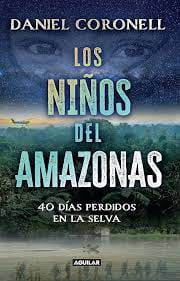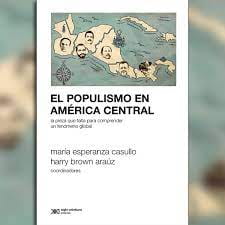A Review of Los niños del Amazonas. 40 días perdidos en la selva by Daniel Coronell

Los niños del Amazonas. 40 días perdidos en la selva by Daniel Coronell (Aguilar, 2023, 218 pages)
Los niños del Amazonas. 40 días perdidos en la selva is the first true book by Colombian journalist Daniel Coronell, whose long and impressive career speaks for itself: news director of manifold networks; recipient of prestigious recognitions such as Emmys, Peabodys and Simón Bolívar prizes; and arguably the most widely read columnist in Colombia, where he is as much admired as he is feared. Gifted with an incisive, meticulous, razor-sharp style, spiced up with a slightly humorous irony and a merciless bite, his investigative journalism has managed to uncover many of Colombia’s biggest political scandals.
The audacity of speaking truth to power elevated him to quasi-heroical status among his followers, who consider him a national treasure of sorts, particularly in the absence of a decent judiciary system. Such valor and such reputation, nevertheless, come at a price in Latin America. Barraged with death threats and ominous ultimatums, a common occupational hazard, Coronell and his family were forced into exile in the mid-2000’s, when they settled in Miami. Fortunately, his urge to unmask the dubious deeds of the powerful and his unfailing endurance in the face of difficulties show no signs of abating: besides serving as president of Univisión news, he currently works for W Radio Colombia and contributes on a regular basis to the online portal Los Danieles, where he has developed a warm and generous relationship with his avid public.
For all the above, it is hardly surprising that a book authored by Daniel Coronell—and not just a mere compilation of his op-eds, such as Recordar es morir (2016), hailed as an unsparing “colonoscopy” of Colombia’s corrupt politics—is regarded as nothing less than an event. Yet Los niños del Amazonas does not belong to the usual “Coronell fare”: drug money, shady characters, crooked justice and murderous violence are not the main protagonists here, although they can be recognized in the background.
Instead, the book focuses on the story, much publicized in 2023, of four huitoto indigenous children whose plane crashed in the Amazon and somehow managed to stay alive, resorting to a diet of seeds and fruits, for a total of forty days before they were found. The story could have been just another instance of human hardship and survival—akin, for example, to the 1972 Andes plane crash, now cinematically spectacularized in Society of the Snow (2023), J.A. Bayona’s film, and to a venerable fictional genealogy, from Robinson Crusoe (1719) and The Jungle Book (1894) to The Lord of the Flies (1954)— if it were not for a series of differentiating circumstances such as, among others, the providential intervention of a shaman-like spiritual leader and his yagé-induced visions.
More than a gradual descent in hell, as is the case with most of Coronell’s procedural columns, the book reads as a rather optimistic narrative in which trauma and misery pave the way for bravery and deliverance; a narrative that encapsulates to perfection the vices and virtues of a whole nation, as much plagued by inequality, racism and violence as blessed with courage and generosity. It is far from a coincidence, then, that Coronell wrote it while undergoing an acute personal and familial crisis. “Many of these pages came to me through tears,” he explains in the acknowledgments, as “the most terrible news arrived together with some hopeful ones” (217). The book is the product of several sleepless nights, composed feverishly, as “a way to save myself,” to quote his own words in a recent interview.
As one would expect, Coronell infuses this captivating tale of both individual and national redemption with his professional know-how. He succeeds at gathering all the, as of today, available evidence and arranging it in a breezy text that certainly evokes—but still does not match—the older masters of Colombian chronicle whom he looks up to, such as the late Germán Castro Caycedo. He adequately situates the story in its proper Amazonian setting. He provides relevant information on the huitoto people, their customs, their beliefs, their continuing historical and cultural struggles. He introduces us to the four children—Lesly, a 13-year-old girl; her sister Soleiny, nine years old; Tien Noriel, a boy of four and Cristin Nerimán, a baby girl—, Magdalena, their mother, and Miller, their stepfather, inclined to domestic violence. He explains why Magdalena and her offspring decided to take that fateful flight on May 1, 2023, final destination Bogotá, risking everything for a better life in the capital, where Miller awaited them. Coronell also dissects, with a painstaking attention to technical minutiae, the reasons behind the Cessna’s failure, which prompted an emergency landing in the Amazon’s canopy and the instant death of its adult passengers, leaving the children to fend for themselves in the forbidding jungle.
He recounts the slow progress of the heterogeneous search party (specialized military forces plus Indigenous locals plus tracking dogs), its organizational structure, its internal frictions, its encouraging early results and its eventual demoralization once false alarms began to pile up and the children proved to be more elusive than initially supposed. With salient cross-cultural empathy, he portrays the involvement of huitoto elder Don Rubio, who, resorting to the traditional intaking of yage—the psychotropic drink also known as ayahuasca—takes control of the desperate rescuers, pinpoints the lost children and puts an end to a mission described as “trying to spot a flea in a huge rug” (108). And he even adds a short epilogue reporting on the children’s subsequent recuperation; the incarceration of their stepfather, Miller, charged with child sexual abuse; and the unfortunate disappearance of the beloved Wilson, one of the trained Malinois dogs. Throughout the book, Coronell cites reports, texts, interviews, taking advantage of the panoply of sources at his disposal. In a purely informative sense, in short, Los niños del Amazonas is the definitive, fact-driven account of what happened.
And yet the book, to the attentive reader, offers much more than what the quick outline above may suggest. The children’s perilous experience, as it happens, synthesizes to perfection the myriad interconnected problems which currently afflict the Colombian nation. Granted, Coronell does not delve as much into this troubled background, and one almost wishes he had done so, if only because it provides plenty of food for thought. Still, one could argue that the full exploration of these questions, however welcome, would have burdened with unnecessary weight what is otherwise a straightforward, scrupulous chronicle. The resilience of those issues, in any case, populate every page of Los niños del Amazonas; they constitute the book’s deep social-historical substratum, simultaneously occasioning and framing the incidents it depicts.
For starters, Coronell mentions the ambiguous position that the huge Amazonian region has occupied and occupies in Colombia: encompassing 42% of the territory but a mere 2% of its total population, this vast, green area has been the object of endless fascination as much as incomprehensible disdain. Two of the nation’s most lauded artistic achievements, José Eustacio Rivera’s novel La Vorágine (1924) and Ciro Guerra’s film El abrazo de la serpiente (2015), represent the Amazonian landscape as mysterious, overwhelming, fearsome even, and determined by the brutal dynamics of an expansive and exploitative frontier: back then the rubber boom, but presently the cocaine plantation industry, global wildlife trafficking, not to mention increasing deforestation, a matter of now global concern. Amazonian indigenous peoples have been historically subjected to a lethal combination of cultural, capitalist, racist and gendered violence, a violence which replicates itself, oftentimes, in their very own domestic sphere, scarring their social tissues.
How ironic, then, that it was precisely the ancient wisdom of the neglected huitoto what proved to be pivotal in the rescue mission. For the huitoto, in spite of inescapable bilingualism and Hispanicized names, have not forgotten their cultural heritage, orally transmitted from generation to generation. Rather than externalized in material objects, their traditions are lodged in their minds and carried in their bodies—given their refusal of cumulative logics and state apparatuses, a common trait in the Amazon, as revealed by Pierre Clastres in Society against the State (1974). Thus, and unlike the mestizo corps, irredeemably deprived of their ancestors’ knowledge, they could distinguish different shades of green and develop efficient tracking methods by identifying footprints, marks, and what one could call, following Claire Denis, “white material” (productos de blanco). Due to the influence of the sacred yagé, moreover, nowadays a cool fixture of “psychedelic tourism,” they were able to engage in spatio-temporal travel and appease the “jungle’s spirits” (137), bargaining with them to finally release the children from their clutches. The latter, incidentally, felt safer in the wild, far from domestic and sexual abuse and “embraced by the jungle” (16), which speaks volumes about the condition of infants in Colombia.
With this book, Coronell confirms his status as one of the foremost Colombian journalists, enlarging with ease the scope of his investigations and presenting his readers a complex snapshot of a problematic, if hopeful, nation. One laments, perhaps, that it seems to lack much of his characteristic ironic sharpness, perhaps most comfortable while unveiling, in well-founded and furiously paced legalese, the outrageous secrets and twisted schemes of the powerful.
Alejandro Quintero Mächler is a Research Scholar and half-time Lecturer in the Department of Romance Languages and Literatures at Harvard University. He is the author of Perder la cabeza en el siglo XIX. Ensayos sobre historia de Colombia e Hispanoamérica (2023).
Related Articles
A Review of Born in Blood and Fire
The fourth edition of Born in Blood and Fire is a concise yet comprehensive account of the intriguing history of Latin America and will be followed this year by a fifth edition.
A Review of El populismo en América Latina. La pieza que falta para comprender un fenómeno global
In 1946, during a campaign event in Argentina, then-candidate for president Juan Domingo Perón formulated a slogan, “Braden or Perón,” with which he could effectively discredit his opponents and position himself as a defender of national dignity against a foreign power.
A Review of Aaron Copland in Latin America: Music and Cultural Politics
In Aaron Copland in Latin America: Music and Cultural Politics, Carol Hess provides a nuanced exploration of the Brooklyn-born composer and conductor Aaron Copland (1900–1990), who served as a cultural diplomat in Latin America during multiple tours.




